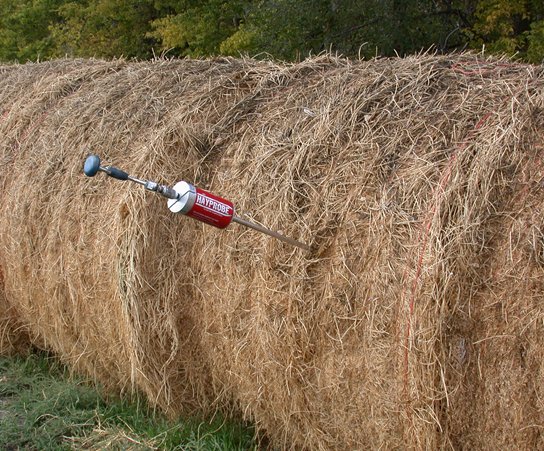
By Brent Plugge, UNL Extension Educator
As producers strive to reduce feed costs by investigating avenues to increase grazing days, many still have to use harvested forages in their year-round feeding program. Sampling and testing forages for quality can make designing a feeding program easy and economical. Nutrient concentration can vary considerably in feeds, especially forages. Protein in alfalfa hay can range from 10 to 25 percent on a DM (dry matter) basis and grass hay may contain between four and 18 percent protein. Beef cattle are most productive when fed or consuming a diet balanced according to their nutrient needs. When designing diets using harvested feeds, many rations are balanced using average values for each feedstuff and these "book values" often result in over- or under-feeding certain nutrients. More economical and better balanced rations can be formulated using nutrient concentrations determined from feed analysis.
From a forage standpoint, as plants mature, fiber concentration increases. Fiber is less digestible than other plant parts and fiber digestibility declines as plants mature. Both of these factors cause the concentration of energy in plants to decline as maturity advances. In addition, as plants mature, the increase in fiber and bulkiness reduces the amount of the forage an animal can consume. For example, cows don't quit eating straw because they don't like it, they quit because they can't place anymore into their rumen because of straw's low digestibility due to the high fiber content. As the plant matures, ADF (acid detergent fiber) and NDF (natural detergent fiber) increase and protein and energy concentration in the plant decline. The biggest factor that impacts forage quality is plant maturity.
Getting a representative sample, packaging it properly for transport, knowing what to test for, and understanding the numbers in the analysis are critical. It is important that samples closely resemble the entire "lot" of forage. Each sample must represent only one "lot" of forage. A "lot" of forage consists of forage harvested from one field at the same cutting and maturity. All forage from the same "lot" should be similar for: type of plant(s), field (soil type), cutting date, maturity, and variety. Variation in any of these characteristics can cause substantial differences in the nutrient value of the forage. Sample baled hay after curing (usually 17 to 21 days after baling), using a core sampler or probe. Such an instrument is essential for collecting a representative sample and most commercial labs will not accept a "grab sample" of hay. For large round and square bales, the probe should penetrate at least 18 inches into the bale and have an internal diameter of at least 3/8-inch. Depending upon how many bales you have in your lot you should collect samples from a minimum of 15 or 10% of the large round bales. Collect a sample from each bale by coring straight in from the center of the end of square bales and from the wrapped circumference of round bales. Place the entire sample into a plastic bag and seal tightly. For chopped or ground hay collect about 10 small samples during grinding process and place all the samples into one plastic bag and seal tightly. If you are sampling previously ground or chopped hay, collect about one-fourth of the samples from the top half of the pile and the rest from the lower half. Avoid allowing fines to sift between fingers. Label the bag with your name, address, lot ID, and type of material. Most testing labs provide a description sheet to report this information and to request the desired tests. Place samples in polyethylene freezer bags, squeeze the air out of the bag, and seal tightly. If you are sending a sample of silage, double bag silage samples for extra protection. Use extra caution if subdividing a large hay sample because sub-sampling dry hay can result in loss of fines and leaves. Freeze samples containing over 15 percent moisture until shipping; store dry samples in a cool location.
It is important to know the nutrient needs of the cattle you are feeding as you may or may not need additional feeds or supplements to meet their requirements. More economical and better balanced rations can be formulated using nutrient concentrations determined from feed analysis.
For more UNL Beef information go to http://beef.unl.edu